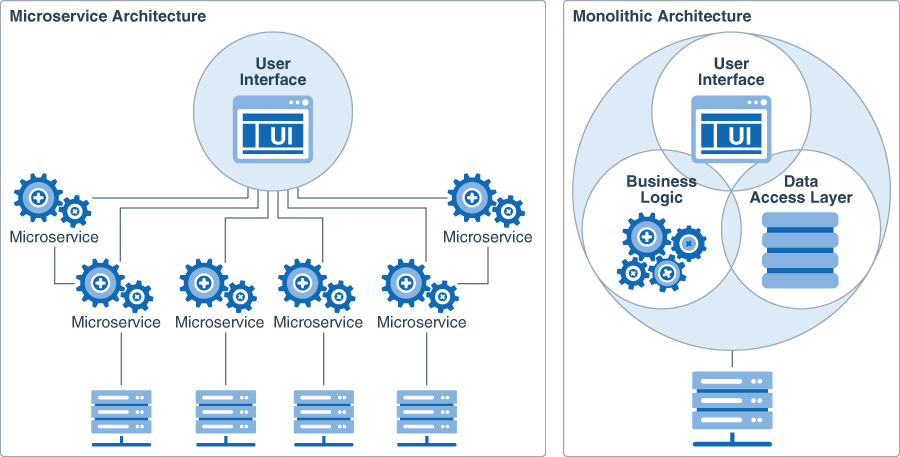The Quick Introduction to Microservices Architecture
Get to know more about the future of the apps development As soon as applications became larger and complex developers faced the challenge to make apps more flexible to changes without compromising the integrity of the entire application. The answer was microservices, a new software architecture that giants like Amazon or Netflix find critical to keep their services functional and practical. Take a look at what is behind microservices and why is changing the way applications are built.

Microservices architecture is tightly connected to container technology. If you want to know more about it, read first our previous article The Ultimate Containerization Guide: Docker, Kubernetes and More.
Microservices are a kind of software development where the software is composed of small independent services that communicate through well-defined APIs.
What are microservices
The traditional language that many applications used for decades was the monolithic architecture pattern.
However, as new apps become larger and complex developers faced new challenges with the software structure. So they started looking for a new way to build applications and that is how microservices architecture emerged.
The “microservices” term was created by a team of software engineers in 2012 but became more popular in 2014 when Mártin Fowler, another well know developer, used the concept quite often in his publications.
According to Chris Richardson, author of Microservices patterns: “Microservices are a sort of architecture that builds an application as a collection of services”. In other words, it is a disintegration of application into several pieces.
Microservices are a kind of software development where the software is composed of small independent services that communicate through well-defined APIs. The owners of these services are independent small teams. Microservice architectures make applications easier to scale and faster to develop.
The goal of microservices is to enable the efficient and fast delivery of complex applications. The services that are part of this architecture have specific characteristics: they are independently deployable, highly maintainable and testable, loosely coupled and organized around business capabilities.
Why is microservices technology so revolutionary?
A monolithic structure means that all components (processes) of the application are integrated and they execute together as a single service. If one of the processes into the application has a peak demand, the entire architecture has to be scaled. So, scaling a monolithic application becomes more difficult as the code grows.
Microservices technology solves this problem. When using microservices, an application is created with independent components that execute each process of the application as a service.
Even when these components/microservices are independent of each other, they work together to achieve the same tasks using lightweight APIs. By making these services run independently, they can be updated, deployed and scaled to meet the needs of specific functions of an application.
One of the biggest advantages the microservices architecture has is that it simplifies the capacity to share similar processes among several applications. For example, microservices are essential for the development and optimization of native applications in the cloud.
In short, microservices technology allows developers to distribute good quality software in a faster way.

Comparison between microservices and monolithic architecture. Source: Oracle Help Center
Examples of microservices appliances
By adopting microservices, businesses try to compete in a demanding market that is continuously asking for fast deployment and scalability of their products.
A good approach to get to know the power of microservices is pointing at some examples of how some of the most important companies use them nowadays.
Amazon
Amazon was among the first companies that migrated his architecture to microservices. For Amazon, microservices are a key technology to attend millions of requests every day connected to their applications, APIs, and even their website.
Amazon engineers admit that their current system will be impossible to manage with a monolithic architecture. They remember how hard was to face the fluctuating traffic demands with a monolithic scheme. Nowadays, Microservices architecture allows Amazon continuous application deployment every 11.7 seconds.
eBay
eBay is another good example of microservices efficiency. The main application of the company uses several microservices that must be able to process millions of requests per day.
According to CTO Steven Fisher, eBay is based on 1000 services that must run within the system. By using microservices, eBay can add new functionalities easier, allocate new development work and decuple unnecessary dependencies.
Netflix
Every day, Netflix receives an average of 1 billion calls to its different services. With these numbers, Netflix accumulates 30% of internet traffic. Netflix all not be able to hold such amount of request without a microservice architecture.
Thanks to microservices, the streaming giant is capable of adapting to more than 800 types of devices trough its vide streaming API. For each user request, Netflix API makes another 5 requests to different servers to keep the service continuity.

Portrait of mid adult businessman standing near cargo container and writing on clipboard. Horizontal shape, side view, copy space
How microservices work with containers
Since microservices changed the way to develop and deliver applications, containers became the best method to encapsulate microservices and simplify functions such as parameters configuration, maintenance, and administration of applications packages.
When you allocate microservices in containers, the hardware performance is better and it is easier to coordinate all the services, including storage, network connection, and security.
Containers and Microservices set up the base for the development of native applications in the cloud. So, the integration of both technologies facilitates the transformation and optimization of existing applications.
Containers help to create replicable copies of the infrastructure, task automatization, save time setting up bunches of applications and also they can identify which components need prevention and corrective actions much faster.
If you want to know more about containers and microservices, read our previous article The Ultimate Containerization Guide: Docker, Kubernetes and More.
Microservices architecture or monolithic architecture?
It is hard to say which architecture is the best since both of them serve for different purposes and have different benefits. Actually, all depends on how complex is the project and the way developers want to go.
It is true that microservices are changing the apps’ development for good in many ways. However, this technology still in its first stage and can be, somehow, challenging.
For example, testing can be quite complex due to the distributed deployment. Microservices require a big amount of memory, and doing the fragmentation of an app in several services can take a lot of time in planning. That´s why many consider microservices building a kind of art.
The future of microservices
With the IoT on the rise, microservices seem to be the solution that most developers will choose to implement applications due to the flexibility for coding, deployment an scaling.
According to the International Data Corporation (IDC) microservices are expected to be adopted by 90 % of the new enterprise applications in 2020 due to the promise of better speed, low cost, and unlimited value-add.
The usability of microservices should be improved soon as well thanks to “best practices manuals” that will help developers with implementation. Also, a better environment for co-existing microservices and monoliths architectures will be possible.
Experts believe that microservices will be much more involved with containerization.



